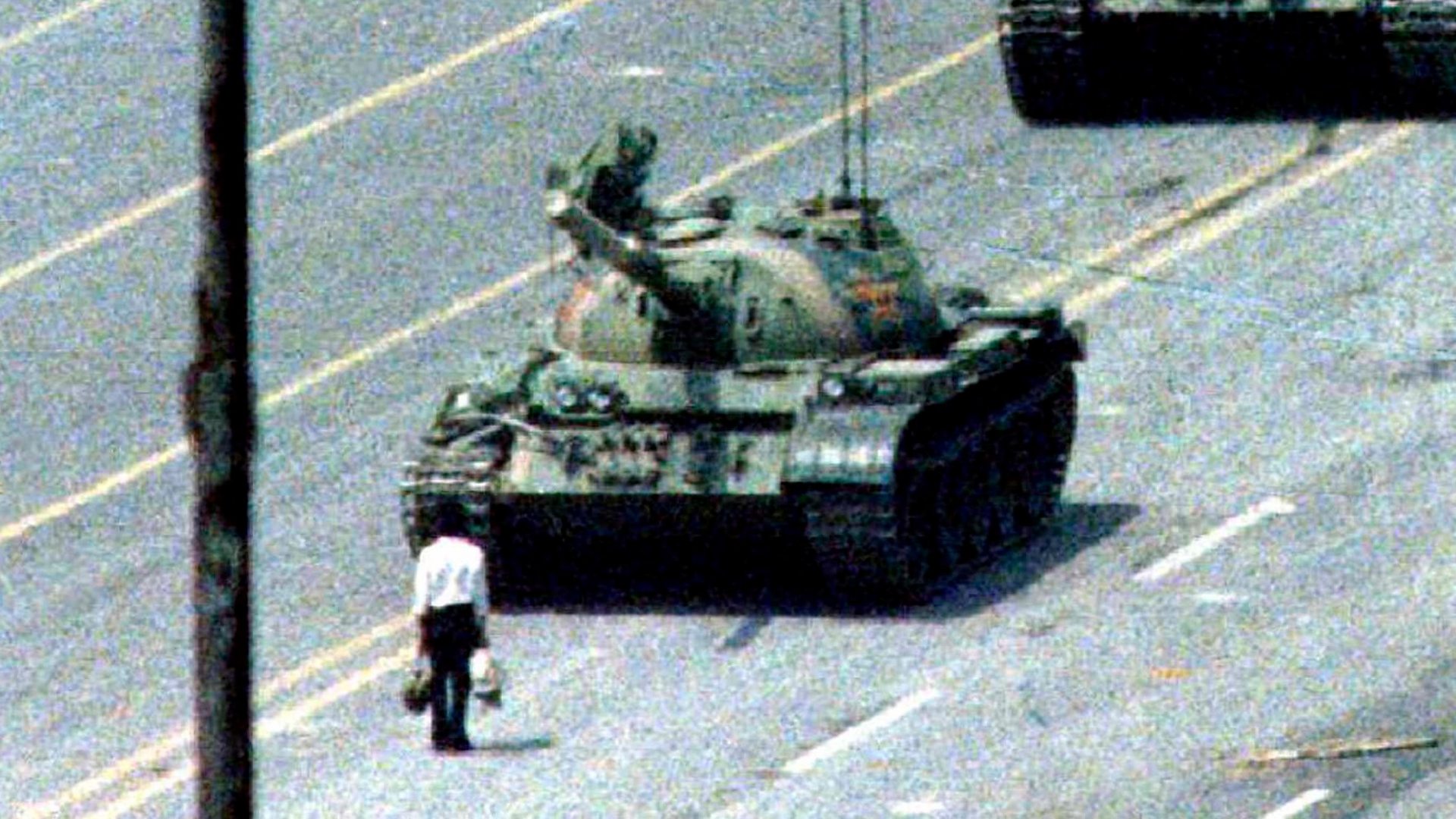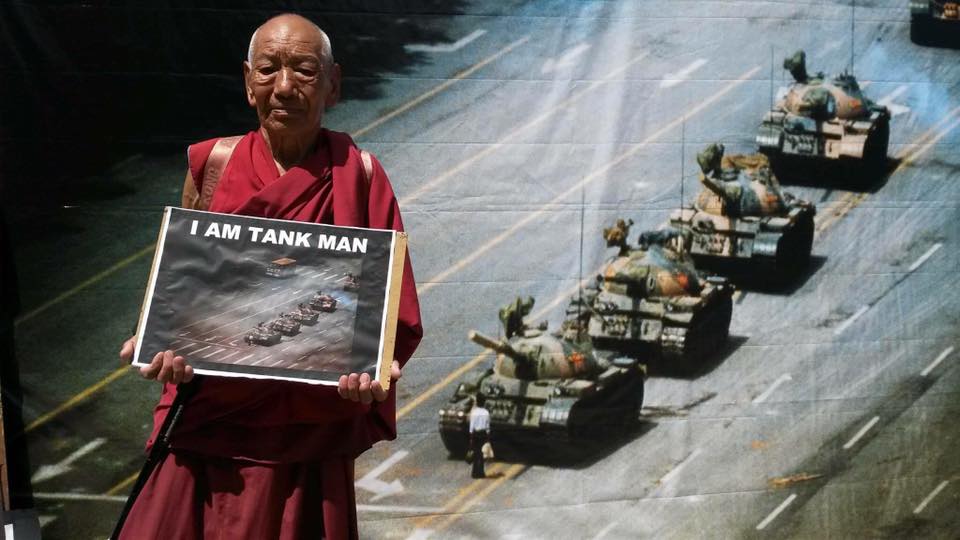
An unknown protester who became known as ‘Tank Man’ stands in front of tanks as they begin to leave Tiananmen Square on June 5, 1989, the day after the Chinese military had brutally suppressed people’s protests. (Photo: Wikimedia Commons)
Whenever I was in Beijing, throughout the 1990s and early 2000s, one of my favorite activities after a day of meetings was to go, either with friends or alone, to dinner in a beautiful restaurant in an old Chinese courtyard house on the edges of the Forbidden City, the ancient Imperial Palace complex of the Ming and Qing dynasties.
After dinner, often close to midnight, I would walk in the moonlight along the walls of the Forbidden City, the waters of the canal lapping in the darkness, soaking in the ancient history.
And then would come a heart-stopping moment, when I would stroll through the final ramparts of the ancient fortress, past soldiers of the People’s Liberation Army (PLA), and out through the ‘Gate of Heavenly Peace’ (Tiananmen), under Mao Zedong’s portrait, into a floodlit, empty, silent, Tiananmen Square.
The first was the cries of those who were gunned down on this day, 36 years ago, in that square, beckoning me, calling on me: “Stand up, speak out, never forget.”

The second was the sole, solitary, iconic image of that one man, with his bag of groceries, unarmed, powerless, yet equipped with a moral power that would last well beyond his lifetime, standing in front of a tank, appealing for peace.
That man, who became known as ‘Tank Man,’ has been an inspiration to me ever since — a symbol of resistance who should inspire us all.
On this anniversary, we mustn’t forget both the courage and sacrifice of the tens of thousands of peaceful protesters, mostly young students, who risked and lost their lives by the thousands, not only in Tiananmen Square and the streets and alleys of Beijing, but across China.
It is also essential that we remember the character of the Chinese Communist Party (CCP), on display that day, and understand the true violent nature of China’s ruling regime.
A regime that turns its guns and tanks on its own people is not legitimate or trustworthy. It is not a regime we should easily do business with.
In the past three and a half decades since the Tiananmen massacre, in which an estimated 10,000 people were killed, the regime has continued to show its true, murderous, repressive colors.
Although through the 1990s and early 2000s there was a brief apparent opening, ever since Xi Jinping took power in 2012, the CCP has become ever more repressive and authoritarian, reverting to a one-man dictatorship.
It has perpetrated a genocide against the Uyghurs, recognised as such by the United States, several parliaments throughout the world, and an independent tribunal chaired by British barrister Sir Geoffrey Nice KC.

It has dismantled Hong Kong’s promised freedoms and autonomy, in defiance of an international treaty, the Sino-British Joint Declaration, and locked up at least 1,000 pro-democracy legislators, lawyers, journalists, activists and human rights defenders in the city — including prominent Catholic media entrepreneur Jimmy Lai whose ‘crime’ was to light a candle and say a prayer at a vigil to commemorate the Tiananmen massacre. The lawyer who helped organize the Tiananmen vigils, Chow Hang-tung, is also jailed.
It has jailed citizen journalist Zhang Zhan, Christian pastor Wang Yi, Uyghur medical doctor Gulshan Abbas, dissident Dr Wang Bingzhang who has been held for 23 years after being abducted from Vietnam, Tibet’s Panchen Lama and his family, and thousands of other, often anonymous, prisoners of conscience across China.
It should free these and all other political prisoners.
Its ever-intensifying repression in Tibet, against Christians and Falun Gong practitioners and dissidents, and human rights defenders throughout China must stop, along with its aggressive campaign of transnational repression against its critics and diaspora dissidents abroad.
As we reflect on the current state of China today, let us take inspiration from the ‘Tank Man.’

When I was researching my book, The China Nexus, published in 2022, I interviewed participants in and observers of the 1989 protests. One of them, Chinese-Canadian journalist Jan Wong, described to me in detail her observations of the massacre.
“They were shooting, people were running, and people tried to rescue others. They brought out bodies on bicycle seats and pedicabs. They just ran into gunfire,” she told me.
Indeed, she narrowly missed a bullet herself, as a gunshot hit the balcony of her hotel from which she had been observing the turmoil.
From that balcony, she witnessed the Tank Man.
“I saw the whole dance between Tank Man and the tank. He tried to stop the tank like a soccer goalie. Then he climbed onto the tank, tried to talk, then climbed down again,” Wong described. “It was amazing and I was crying.”
No one knows Tank Man’s name or what happened to him. But everyone knows the impact he had. He showed the whole world the power that one person can have against a powerful regime. He showed the world that the power of moral courage can outgun the power of a bullet.
Today is an anniversary to be engraved on every human heart. Not as a memorial, but as a motivation.
On this day, 36 years ago, the people of China stood up. And whenever they could since then, they have done the same. As the people of Hong Kong did in 2014 and 2019, and as those who unleashed the White Paper movement across China in 2022.
The people of China long to be free.
The CCP has shown a brutal and vengeful determination to repress that dream.
The rest of the world has a choice to make — on whose side do we stand?
I know on whose side I stand. That of the people of China.
I stand with Tank Man.
It is time now for you, and for governments around the world, to make that choice too.
It is time, this June 4, to work towards a free China.
*Benedict Rogers is senior director of Fortify Rights, co-founder of Hong Kong Watch, and author of “The China Nexus: Thirty Years In and Around the Chinese Communist Party’s Tyranny.” The views expressed in this article are those of the author and do not necessarily reflect the official editorial position of UCA News.